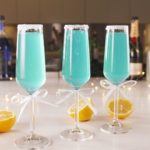Classic Tasting Redux – 1990 Opus One
 A slight departure from our normal wine reviews, thought this may interest those who may still have some older bottles in their cellar and for educational purposes, for those who may want to cherish a particular bottle for future enjoyment. We revisit the 29 year old California classic 1990 Opus One. But first, a little personal back story history.
A slight departure from our normal wine reviews, thought this may interest those who may still have some older bottles in their cellar and for educational purposes, for those who may want to cherish a particular bottle for future enjoyment. We revisit the 29 year old California classic 1990 Opus One. But first, a little personal back story history.
Back when the Robert Mondavi – Baron Phillipe de Rothschild collaboration was all the rage in California wine, I purchased a case of the 1990 Opus One that was to reside in my cellar for a number of years of drinking pleasure. Over the next 10 years, a few were opened and enjoyed with family, friends and feasting. At one point, when the wines were about 10 years of age, I had noticed a small blotch of red wine staining on my cellar floor. I traced it upward in my racking from where the stain had occurred and noticed that a bottle of Opus was leaking from under its foil. Alarmed, I opened the bottle and found no spoilage to the wine itself, which was happily consumed a bit earlier than expected and chalked up the incident to things happen. Result: Strike One
It wasn’t but another 4 months or so later, I notice another pool of red wine in almost the exact spot from the previous occurrence. Sure enough, I follow the line straight up, to my surprise, another leaking bottle of 1990 Opus One. At this point, my instincts led me to believe that in this particular vintage, they must have had some defective cork issues. A wine of this caliber and pedigree certainly had the highest of standards when it comes to premium corks, bottles and all things related to their luxury brand. I let it go in hopes that I had no more problems with the bottles that I had left in my cellar. Result: Strike Two.
Fast forward to the following Fall when I once again had the pleasure to experience harvest season in Napa Valley and sample many of the latest vintages at numerous wineries where I had tasting appointments. Just so happens, I was invited to taste and tour the Opus One winery, one of the most beautiful facilities in all the valley.
At one point during our tour, our winery host happened to ask if anyone had any questions. I brought up my two incidents involving my leaking bottles with their 1990 vintage and asked if there were any known problems with their corks that particular year. My host assured me about their high standards and quality control on every aspect of production of their Opus One wines. I then proceeded to relate my tale of woe about the 2 leaking bottles. Without hesitation, without as much as a thought to a possible problem on their part, he looked me straight in the eye and said that “Sir, I think you have a major problem with your cellar”. Knowing full well that my cellar was indeed not the problem, knowing that this host did not even know anything about my cellar, knowing full well that he did not even want to admit that the winery may well have had an unknowing issue on their hands, he put the full blame on me. Ignoring any further discussion about the subject, our host abruptly ended our tour without another word being spoken. Result: Strike Three.
Our little tete a tete ended on a sour note with myself vowing to never support, recommend, purchase or drink a bottle of Opus One ever again. I sold off my remaining bottles I had in my collection and for years at our store, if you wanted a bottle of Opus One, I was glad to sell it to you only if you requested it by name. If someone asked my opinion, none was ever given.
Fast forward to this past weekend where a bottle of 1990 Opus One was reintroduced. Good friends happened to read my latest blog regarding Wine Myth’s and one of the subjects regarding older vintages reminded them that they had a bottle sitting in their basement. They questioned whether it was still good enough to drink. My reply was, you never know until you try it. Hence, the bottle was brought to my home and exploration was about to begin.
The bottle looked pristine, no floating sediment, perfect label and no signs of leakage. The ullage was down about 3/4 of an inch in the neck of the bottle but that was to be expected for a wine of this age. Removing the foil, my initial fear was starting to reveal itself. Mold and dried red wine from leakage was evident on the neck and foil. The cork itself had noticeably shrunk and had fallen slightly into the bottle. Using my Ahso prong opener, it wasn’t long before the cork started to break apart and it was time to pull out a decanter.
Pushing the remaining cork into the bottle, I proceeded to filter the wine into the decanter without incident. The juice still had a nice garnet coloring with a slight tinge of browning. Pouring a glass for all to sample, I sniffed to reveal notes of leather, tar, cigar box, dried herbs, a touch of smoke and earthiness. The fruit itself was a bit subdued, showing dried plum, dusty cherry and a whiff of cocoa powder.
All in all, it was not dead by no means, still quite drinkable, reminding me of an old Bordeaux where the fruit and nuances had flipped places over time, resulting in what a typical older vintage bottle would taste like. When Mr. Mondavi and Mr. Rothschild first envisioned the creation of Opus One, it was to blend the best of France yet made in a California style. The grape varietals used were Cabernet Sauvignon, Cabernet Franc and Merlot, the a similar make up of the wines from the Bordeaux region.
Though we enjoyed our few initial sips, it would have been a stretch to further enjoy the rest of the wine in its present state, that being a bit dry and not as fruit forward for our liking. Taking things one step further, I went to my cellar and pulled a California wine with the same varietal make up of Cab, Cab Franc and Merlot. Adding like amounts of the two wines into our glasses, we all agreed that blending the two together revitalized the Opus One, giving it a much fresher, smoother and more exciting flavor.
It was certainly an unexpected treat to sample the Opus One after so many years. If you happen to still have this wine in your cellar, I would highly suggest pulling a bottle and trying it to examine its current state of aging. It would also be my suggestion that any bottles that are resting in your cellar, regardless of country of origin, from vintage 2005 and older, be aware that they may have reached their peak and may not benefit from any further cellaring. There is no way to recoup your investment dollar once a wine deems itself undrinkable, which is why you should always heed my motto: Better to drink a wine a day too early rather than a day too late.



